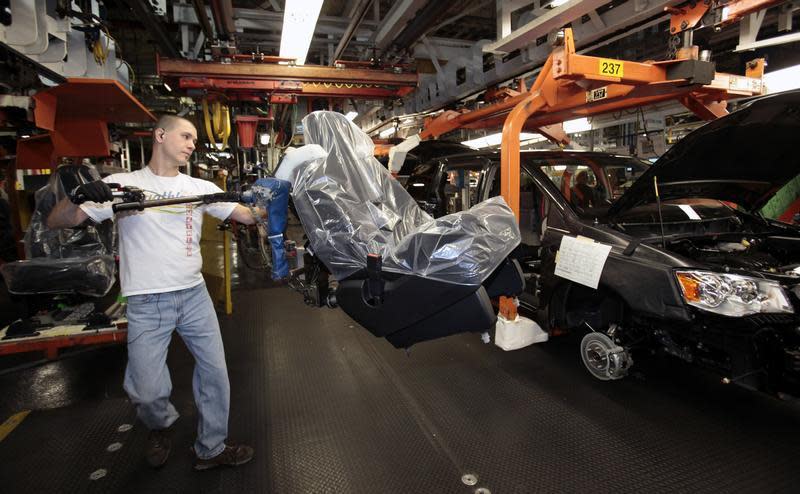Seismic shift happening in Ontario labour market as manufacturing falters

Kaylie Tiessen was right on trend with the recent release of a report examining Ontario’s changing labour market and, notably, the loss of manufacturing jobs.
She was maybe even a little ahead of the curve given all the chatter around employment ahead of what promises to be a contentious provincial election.
Whether it’s around the creation of green jobs in Toronto, local food production or aerospace, “I have certainly heard a number of references to manufacturing over the past month,” Tiessen, an economist with the Canadian Centre for Policy Alternatives, told Yahoo Canada Finance.
Tiessen's report is meant to kick start a much-needed conversation around what she calls a “seismic shift” in Ontario's labour market, and what can be done to get thousands of residents back into meaningful employment.
In particular, Tiessen looked at the well-paying manufacturing sector, once the bedrock of Ontario’s economy and now a mere shadow of its former self.
The spiral downward began long before the recession hit in 2008, said Tiessen. Indeed, she found 290,000 jobs have been lost in the sector between 2000 and 2013.
No corner of the province has been immune to the changes. According to Tiessen, every economic region has lost at least 18 per cent of the manufacturing jobs that existed at the start of the millennium.
Hardest hit has been northwestern Ontario which shed 60 per cent of its manufacturing jobs between 2000 and 2013. Kitchener-Waterloo and Barrie saw the smallest relative decrease in manufacturing jobs at 18.5 per cent.
In absolute numbers, Windsor-Sarnia, Ottawa and Kitchener-Waterloo, and Barrie have lost the most manufacturing jobs since 2000, Tiessen found.
Job creation, meanwhile, has been uneven across the province. Most, about 125,000, new jobs have been concentrated in the service sector, with Kitchener-Waterloo and Barrie benefiting another 20,000 new jobs in the goods-producing sector.
Windsor-Sarnia has seen its labour market shrink by 7,000 jobs since 2000. London has not fared much better. Since 2008, the region has lost over 12,000 full-time jobs, 6,000 of which have been replaced with part-time work.
Tiessen found salaries, too, are becoming more polarized. And while many of the new jobs that have replaced manufacturing have been high paying jobs in technology and health care, “unfortunately, many more are precarious and offer lower pay,” she said.
Weighing in with its own strong views on the topic, CIBC issued its own report this week that, while acknowledging the manufacturing sector’s troubles, suggests there is reason to believe the worst may be over.
"A different manufacturing sector is rising from the ashes," wrote Benjamin Tal, CIBC deputy chief economist and co-author of the report.
Like Tiessen, Tal, notes the sector has undergone a significant challenge over the last 10 or more years. In the glory days of the early 2000s, manufacturing represented 16 per cent of the nation’s economy. Today, that figure is closer to 12 per cent.
Since 2008, manufacturing remains about 10 per cent behind pre-recession highs, while one-fifth of firms no longer exist.
Of the survivors, Tal sees better times ahead, with wood product industries poised for the strongest come back, followed by primary metal, machinery, aerospace and electronic suppliers.
"The long and painful adjustment is starting to pay off, with many industries better positioned to take advantage of the weaker dollar to regain positions in U.S. markets and to better integrate into global supply chain opportunities," Tal said.
With more than 300 aerospace firms in Ontario, Tiessen said communities along the 401 corridor stand to gain from strategic investment to ensure the industry’s growth in these crucial times.
The rebound of wood products will also benefit northern regions.
But she cautioned against relying too heavily on the U.S. economy to pull the province out of the mud. Instead, she called on policy makers to find new solutions to address the shift in the economic landscape.
“There's no going back to the labour market of the 1990s,” she said.

 Yahoo Finance
Yahoo Finance 
